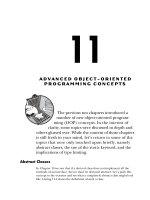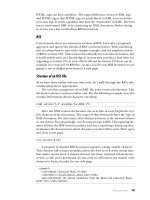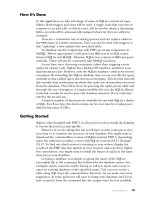OBJECT-ORIENTED PHP Concepts, Techniques, and Code- P20 ppsx
Bạn đang xem bản rút gọn của tài liệu. Xem và tải ngay bản đầy đủ của tài liệu tại đây (263 KB, 10 trang )
Conversion Table: PHP 4 and PHP 5 171
Operators
function foo($variable) function foo(&$variable)
Note that this example shows a
function declaration, not a function
call. Passing objects by reference
explicitly is recommended in PHP 4,
but not required in PHP 5 because
objects are automatically passed by
reference. In PHP 5, you only ever
need use a reference as a parameter
with non-objects.
foo(&$var);
Deprecated. Call-time pass by reference is
deprecated in PHP 5. For more
information see Appendix A. Use a
reference in the function definition
when passing non-objects (not
required for objects, as noted
above).
==&
In PHP 5 assignment of objects
is equivalent to assignment by
reference under PHP 4.
$obj = new ClassName(); $obj =& new ClassName();
In PHP 5 new automatically returns a
reference. PHP 4 style is deprecated.
clone =
In PHP 4 assignment clones an object.
instanceof is_a
is_a
is the only function of the
Class/Object functions that has
been deprecated (as of PHP 5).
Other Changes of Interest
get_class,
get_class_methods, and
get_parent_class
get_class
,
get_class_methods, and
get_parent_class
In PHP 5 these methods return a
case-sensitive result.
functionName(ObjectType $o)
N/A In PHP 5 you may type hint object
parameters to functions. As of PHP
5.1 you may also type hint arrays.
Type hinting return values of functions
or methods is also planned. This will,
of course, only apply to objects.
PHP 5 PHP 4 Notes
OOPHP_02.book Page 171 Friday, May 5, 2006 2:25 PM
OOPHP_02.book Page 172 Friday, May 5, 2006 2:25 PM
GLOSSARY
A
abstract method A method that is declared but not defined. Any class that
contains an abstract method must use this keyword in the class definition. All
of the methods of an interface are abstract. A class that has only abstract
methods is a pure abstract class.
accessor method A public method used to retrieve or change data mem-
bers. Accessor methods are also called get and set methods. (It is considered
good programming practice to make data members private and alter or
retrieve them only through accessor methods.)
aggregate class A class having at least one data member that is itself an
object
application programming interface (API) The public face of a class
Asynchronous JavaScript and XML (AJAX) A web development technique
that incorporates JavaScript, XML, and other tools; typically entails use of the
JavaScript DOM object XMLHttpElement to communicate with the server
and refresh web page elements without reloading the entire page
OOPHP_02.book Page 173 Friday, May 5, 2006 2:25 PM
174 Glossary
B
backward compatibility A characteristic of a version of a programming
language or application that allows it to work with previous versions or files
created using previous versions
base class A class from which other classes are derived; also called a parent
class or superclass
C
call time The time at which a function or method is invoked
Cascading Style Sheets (CSS) A web design technique that separates the
content and presentation of a web page. Style sheets are cascading because
they can be applied from an external file, within the style section of a web
page, or inline, and each lower level overrides any style characteristics
defined previously.
child class See derived class.
class A complex data type that typically includes both data members and
methods; the most fundamental element of OOP
class variable A static data member belonging to the class as a whole and
not to any specific instance
client programmer The user of a class rather than the creator or originator
of a class; sometimes referred to as a user programmer
const A keyword, new to PHP 5, used to define constant class data
constructor A special function called when objects are created. In PHP 4
the constructor uses the class name. This style of constructor still works in
PHP 5, but the recommended practice is to define the method
__construct.
D
data hiding The ability to restrict and control access to data members; also
called data protection
data member A variable declared within a class but outside any method;
also called a property or instance variable
Data Source Name (DSN) The specification of the driver and resources
necessary to create a PHP Data Object
deprecated No longer recommended usage, obsolete; for example,
“The
is_a function is deprecated as of PHP 5.” (The deprecated entity will
eventually be extinct from the language.)
design pattern A general description of a solution to a design problem;
somewhat akin to an abstract class or interface, but even less specific
OOPHP_02.book Page 174 Friday, May 5, 2006 2:25 PM
Glossary 175
destructor The opposite of a constructor, invoked automatically whenever
an object goes out of scope; usually ensures that any resources, such as file
handles, are properly disposed of
derived class Any class that has a base or parent class; also called a child class
or subclass
Document Object Model (DOM) The representation of an HTML or XML
document in object-oriented fashion
E
encapsulation A process that allows implementation details irrelevant to a
client programmer to be kept private and not exposed as public methods or
public data members; related to data hiding but more comprehensive
extends The keyword used when inheriting from a class; for example, class
Canary extends Bird
Extensible HyperText Markup Language (XHTML) See XHTML.
Extensible Markup Language (XML) See XML.
F
final A modifier applied to methods or classes that restricts inheritance; a
final class cannot be extended, and a final method cannot be overridden
forward compatibility Writing code with future upgrades to the language
in mind; for example, avoiding the use of deprecated coding styles
G
garbage collection Automatic memory management that removes
references to resources that are no longer used
H
HTML (HyperText Markup Language) A simple markup language derived
from SGML and used to create web pages
I
implements The keyword that replaces extends when inheriting an interface
rather than a class
inheritance The ability of an OO language to pass the methods and data
members of an existing class on to a new class
instance A specific occurrence of a class; creation of a class object is
referred to as instantiation
interface 1. A keyword in PHP indicating a class that declares methods but
does not define them. PHP allows multiple interfaces to be inherited. 2. The
public methods of a class.
OOPHP_02.book Page 175 Friday, May 5, 2006 2:25 PM
176 Glossary
Iterator An interface, built in to PHP 5, that allows objects to be traversed
J
Javadoc format A format for internal comments; the getDocComment method
of the reflection classes can extract comments formatted in this way
M
magic method A method that begins with a double underscore and is
usually invoked indirectly.
__sleep and __wakeup are magic methods in
PHP 4. A number of magic methods are new to PHP 5, most importantly
the
__construct and __clone methods.
metadata Data that describes other data; for example, information about
the structure of a database
method A function defined within the scope of a class
Multipurpose Internet Mail Extensions (MIME) The standard Internet
email format, but more broadly, a content type specification such as
“image/jpeg”
N
name/value pair The format for a query string passed to a web page; any
query string is composed of one or more name/value pairs. Access is pro-
vided by the global arrays
$_POST or $_GET, with the name functioning as the
array key.
overloaded A characteristic of a method; describes the ability to behave
differently when supplied with different parameters. In PHP, this term is
usually applied to the
__call, __set, and __get methods, in the sense that one
method may handle a number of different methods or properties. (Because
PHP is a weakly-typed language, you cannot have an overloaded method as
understood in some other OO languages—namely, one method name but
different method signatures.)
override The act of redefining the method of a parent class in a child class
P
parent class See base class.
PHP Data Object (PDO) A group of classes that provides a data-access
abstraction layer, included by default with PHP version 5.1 and higher;
drivers are available for databases commonly used with PHP
PHP Extension and Application Repository (PEAR) A library of open-
source code, organized into packages that are easily installed using the PEAR
installer
OOPHP_02.book Page 176 Friday, May 5, 2006 2:25 PM
Glossary 177
polymorphism Properly speaking, the ability to copy a child object into a
variable of the parent type and still invoke the methods of the child against
that parent object; used somewhat loosely when applied to PHP
private A keyword used to modify the methods or data members of a class;
private elements can only be accessed from within the class or indirectly
through accessor methods and cannot be inherited
procedural A type of computer language that makes extensive use of
procedures or function calls; for example, the C language is a procedural
language, while PHP can be used procedurally or in an object-oriented
fashion
property Synonymous with instance variable or data member
protected A keyword that can be applied to methods or data members.
Like the private elements of a class, protected elements may not be accessed
outside the class; unlike private elements, protected elements are inherited
by derived classes.
prototype The declaration of a function prior to defining it (some lan-
guages, but not PHP, require this); can be applied to the declaration of a
method, especially with regard to interfaces
public A keyword that modifies the methods or data members of a class;
public methods of a class, sometimes referred to as a class’s interface, can be
invoked against an instance of the class, and are inherited by derived classes
Q
query string One or more name/value pairs passed to a web page as part of
the URL
R
RSS (Really Simple Syndication or Rich Site Summary) Often referred to as
a news feed; conforms to a specific XML format
S
scope The context within which a variable can be accessed. A variable
defined within a method may be referenced only within that method,
whereas the scope of an instance variable is the entire class.
scope resolution operator The operator
::, used in conjunction with the
class name when referencing constants or static methods
shallow copy A copy of an object that is not independent of the original.
When copying aggregate objects, special care must be taken to avoid creating
a shallow copy.
signature A unique property of a function or method, consisting of the
function or method name and the number and data type of its parameters;
OOPHP_02.book Page 177 Friday, May 5, 2006 2:25 PM
178 Glossary
used loosely when applied to PHP. In strongly-typed languages, methods can
have the same name as long as the number or type of parameters differ and
they have unique signatures.
Standard Generalized Markup Language (SGML) An international
standard for representing documents; both HTML and XML are derived
from SGML
Standard PHP Library (SPL) A collection of classes built in to PHP
static A modifier applied to a class method or variable that allows access to
that element without having to create an instance of the class; static variables
or methods are common to all instances of a class
studly caps A naming convention in which each appended word of a
compound name is capitalized; sometimes referred to as CamelCase. Class
names use upper CamelCase (as in
DirectoryItem) and methods use lower
CamelCase (as in
getName).
T
type hinting The ability to restrict the kind of object passed to a function or
method by preceding a parameter name with an object type in the function
or method definition; arrays may also be type hinted as of PHP 5.1
W
weakly-typed Used to describe a language, like PHP, in which data type
identification is not required when declaring a variable
Web Services Definition Language (WSDL) An XML format that describes
a web service
World Wide Web Consortium (W3C) The organization responsible for
developing standards for the World Wide Web
wrapper method A method that simply encloses an existing function call
X
XHTML (eXtensible HyperText Markup Language) An XML-compliant
form of HTML
XML (eXtensible Markup Language) A markup language, like HTML,
derived from SGML; XML-compliant documents must meet stricter
requirements than HTML documents
Z
Zend engine The scripting engine that underlies PHP; it was entirely
rewritten for PHP 5 in order to support the improved OO capabilities
OOPHP_02.book Page 178 Friday, May 5, 2006 2:25 PM
INDEX
Special Characters
$_SERVER global variable, 44, 62
$this. See pseudo-variable $this
A
abs function, 95
abstract class, 88, 91–92
abstract keyword, 88, 92, 169
abstract method, 88, 92–93
of an interface, 133
must be public, 92
access modifiers, 7, 9, 12, 26–31
as internal documentation, 27
as language constraints, 6
protected, 77
as self-documenting, 7
accessor methods, 16, 27, 112,
113, 121
superiority of, 43
active. See anchor pseudo-classes
adapter class, 88
aggregate
class, 79, 119–120
object, cloning, 120
AJAX (Asynchronous JavaScript
and XML), 100, 104, 105,
109–110
Ajax.Updater object, 109–110
allow_call_time_pass_reference, 166
anchor pseudo-classes, 59
Apache web server, 18
configuring, 165–166
directive,
LoadModule, 166
mod_rewrite, 49
array
array-related functions, 20
associative, 29, 31
initializing data member as, 37
array_key_exists function, 153
array_slice function, 58
arrayQuery, SQLiteDatabase method,
149, 150
arrow operator, 22
assignment by reference
operator, 22
assignment operator, 14–15, 171
under PHP 4, 117, 171
under PHP 5, 117, 125, 171
associative array, 29, 31
asterisks, used to format internal
comments, 136
Asynchronous JavaScript and XML
(AJAX). See AJAX
attribute of an object, 17
auto_increment, attribute in MySQL,
70, 143
__autoload, magic method,
115–116, 170
autonumber field, in SQLite, 143
B
backward compatibility, 12,
14–15, 28
base class, 8, 76
behavior
adding to a class, 23
of objects, 6, 7, 8
bindParam, PDOStatement method, 162
OOPHP_02.book Page 179 Friday, May 5, 2006 2:25 PM
180 INDEX
blueprint, class as, 22
braces, used for defining a class, 19
buffered result set, 87, 145, 148, 149
built-in classes, 12–14
naming conventions, 19
C
C++, 4, 5, 20, 94
__call, magic method, 114–115
used with MySQL class, 115
call_user_func_array function, 115
call-time pass by reference, 166,
167, 170
calling an object method, 22
Cascading Style Sheet (CSS).
See CSS
catch block, 13
order of blocks, 84
catch keyword, 83, 170
catching exceptions, 76, 78, 83–84
channel
element of an RSS document,
101–103
sub-elements, 101, 102
character encoding, 101, 106
characteristics of a class, 6
child class, 8, 76, 84
class
as blueprint, 6
characteristics of, 6
concept of, 6
constants. See constant data
members
creators, 27
definition file, 115
including, 22
definition of, 6
instance of, 23
method, declaration of, 20
names, avoiding hard-coding, 28
naming conventions, 19
as template, 6, 7, 9, 22
as user-defined data type, 6
__CLASS__ constant, 80, 81
class keyword, 19, 170
Class/Object functions, 129, 171
cleanData, SQLiteDatabasePlus
method, 154
client programmer, 27, 50, 70
concerned with public
methods, 30
__clone, magic method, 79, 116,
121, 170
clone operator, 79, 116,
118–122, 170
close, MySQLConnect method, 68
command-line version of SQLite,
141, 142
comments, formatting for the
Documenter class, 136
compile-time error, 80
complex expression, 103
connecting to different database
servers, 68
connection error messages, 68
const keyword, 82, 170
constant data members, 80, 82
constants, 60
__construct, Documenter class
method, 132
__construct, magic method, 28, 37,
111, 170
constructor, 19, 20, 28–31
default values, 30, 39, 40
different ways of calling, 39, 40
initializing data members, 19
magic method, 31
methods called from, 40–41
returning object from, 28
for
SQLiteDatabase, 141, 146
using class name, 22, 29
convenience methods, 112,
115, 123
copy
by cloning, 118
constructor, 79, 121
of data member, 27
copying objects, 14
count function, 73
COUNT, aggregate SQL function, 70,
148, 150
createDataMemberArrays, Documenter
class method, 132
OOPHP_02.book Page 180 Friday, May 5, 2006 2:25 PM









